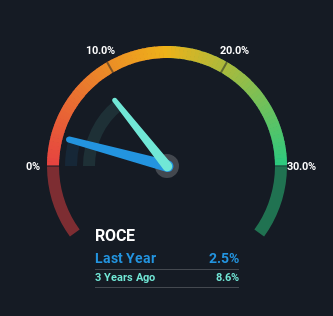- South Korea
- /
- Electronic Equipment and Components
- /
- KOSDAQ:A198080
Some Investors May Be Worried About NPD's (KOSDAQ:198080) Returns On Capital
To avoid investing in a business that's in decline, there's a few financial metrics that can provide early indications of aging. More often than not, we'll see a declining return on capital employed (ROCE) and a declining amount of capital employed. This combination can tell you that not only is the company investing less, it's earning less on what it does invest. In light of that, from a first glance at NPD (KOSDAQ:198080), we've spotted some signs that it could be struggling, so let's investigate.
What Is Return On Capital Employed (ROCE)?
For those that aren't sure what ROCE is, it measures the amount of pre-tax profits a company can generate from the capital employed in its business. Analysts use this formula to calculate it for NPD:
Return on Capital Employed = Earnings Before Interest and Tax (EBIT) ÷ (Total Assets - Current Liabilities)
0.025 = ₩2.6b ÷ (₩210b - ₩108b) (Based on the trailing twelve months to September 2023).
So, NPD has an ROCE of 2.5%. In absolute terms, that's a low return and it also under-performs the Electronic industry average of 6.5%.
View our latest analysis for NPD

Historical performance is a great place to start when researching a stock so above you can see the gauge for NPD's ROCE against it's prior returns. If you're interested in investigating NPD's past further, check out this free graph covering NPD's past earnings, revenue and cash flow.
What The Trend Of ROCE Can Tell Us
There is reason to be cautious about NPD, given the returns are trending downwards. To be more specific, the ROCE was 8.6% three years ago, but since then it has dropped noticeably. On top of that, it's worth noting that the amount of capital employed within the business has remained relatively steady. Since returns are falling and the business has the same amount of assets employed, this can suggest it's a mature business that hasn't had much growth in the last three years. So because these trends aren't typically conducive to creating a multi-bagger, we wouldn't hold our breath on NPD becoming one if things continue as they have.
On a side note, NPD's current liabilities have increased over the last three years to 51% of total assets, effectively distorting the ROCE to some degree. If current liabilities hadn't increased as much as they did, the ROCE could actually be even lower. And with current liabilities at these levels, suppliers or short-term creditors are effectively funding a large part of the business, which can introduce some risks.
The Bottom Line On NPD's ROCE
In the end, the trend of lower returns on the same amount of capital isn't typically an indication that we're looking at a growth stock. Investors haven't taken kindly to these developments, since the stock has declined 27% from where it was three years ago. That being the case, unless the underlying trends revert to a more positive trajectory, we'd consider looking elsewhere.
On a final note, we found 3 warning signs for NPD (2 are concerning) you should be aware of.
For those who like to invest in solid companies, check out this free list of companies with solid balance sheets and high returns on equity.
New: AI Stock Screener & Alerts
Our new AI Stock Screener scans the market every day to uncover opportunities.
• Dividend Powerhouses (3%+ Yield)
• Undervalued Small Caps with Insider Buying
• High growth Tech and AI Companies
Or build your own from over 50 metrics.
Have feedback on this article? Concerned about the content? Get in touch with us directly. Alternatively, email editorial-team (at) simplywallst.com.
This article by Simply Wall St is general in nature. We provide commentary based on historical data and analyst forecasts only using an unbiased methodology and our articles are not intended to be financial advice. It does not constitute a recommendation to buy or sell any stock, and does not take account of your objectives, or your financial situation. We aim to bring you long-term focused analysis driven by fundamental data. Note that our analysis may not factor in the latest price-sensitive company announcements or qualitative material. Simply Wall St has no position in any stocks mentioned.
About KOSDAQ:A198080
Flawless balance sheet and fair value.
Market Insights
Community Narratives



